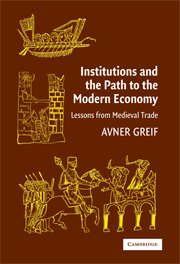Book contents
- Frontmatter
- Contents
- Abbreviations
- Preface
- I Preliminaries
- II Institutions as Systems in Equilibria
- III Institutional Dynamics as a Historical Process
- 6 A Theory of Endogenous Institutional Change
- 7 Institutional Trajectories: How Past Institutions Affect Current Ones
- 8 Building a State: Genoa's Rise and Fall
- 9 On the Origin of Distinct Institutional Trajectories: Cultural Beliefs and the Organization of Society
- IV The Empirical Method of Comparative and Historical Institutional Analysis
- V Concluding Comments
- Appendixes
- References
- Index
- POLITICAL ECONOMY OF INSTITUTIONS AND DECISIONS
6 - A Theory of Endogenous Institutional Change
Published online by Cambridge University Press: 05 September 2012
- Frontmatter
- Contents
- Abbreviations
- Preface
- I Preliminaries
- II Institutions as Systems in Equilibria
- III Institutional Dynamics as a Historical Process
- 6 A Theory of Endogenous Institutional Change
- 7 Institutional Trajectories: How Past Institutions Affect Current Ones
- 8 Building a State: Genoa's Rise and Fall
- 9 On the Origin of Distinct Institutional Trajectories: Cultural Beliefs and the Organization of Society
- IV The Empirical Method of Comparative and Historical Institutional Analysis
- V Concluding Comments
- Appendixes
- References
- Index
- POLITICAL ECONOMY OF INSTITUTIONS AND DECISIONS
Summary
A prerequisite to studying endogenous institutional change is recognizing the mechanism that causes institutions to persist in the absence of environmental changes and to exhibit stability despite environmental changes. Sociologists such as Berger and Luckmann (1967), Searle (1995), and Giddens (1997) have long noted the importance of studying the mechanisms causing an endogenous institution to persist once it has prevailed. But sociology has not offered a satisfactory analytical framework with which to study the phenomenon. As Scott notes, “The persistence of institutions, once created, is an understudied phenomenon [in sociology]…. The conventional term for persistence – inertia – seems on reflection to be too passive and nonproblematic to be an accurate aid to guide studies on this topic” (1995, p. 90; see also DiMaggio and Powell 1991a, p. 25; Thelen 1999, p. 397).
In economics the study of institutional persistence is usually referred to as the study of institutional path dependence (North 1990; David 1994; Greif 1994a). The idea of path dependence was originally developed to study technology (David 1985; Arthur 1988, 1994). It postulates that “the present state of arrangements” requires examining the “originating context or set of circumstances and …[the] sequence of connecting events that allow the hand of the past to exert a continuing influence upon the shape of the present” (David 1994, p. 206).
The game-theoretic analytical framework and the view of institutions developed in the previous chapters highlight a particular mechanism for institutional persistence.
- Type
- Chapter
- Information
- Institutions and the Path to the Modern EconomyLessons from Medieval Trade, pp. 158 - 186Publisher: Cambridge University PressPrint publication year: 2006
- 1
- Cited by



